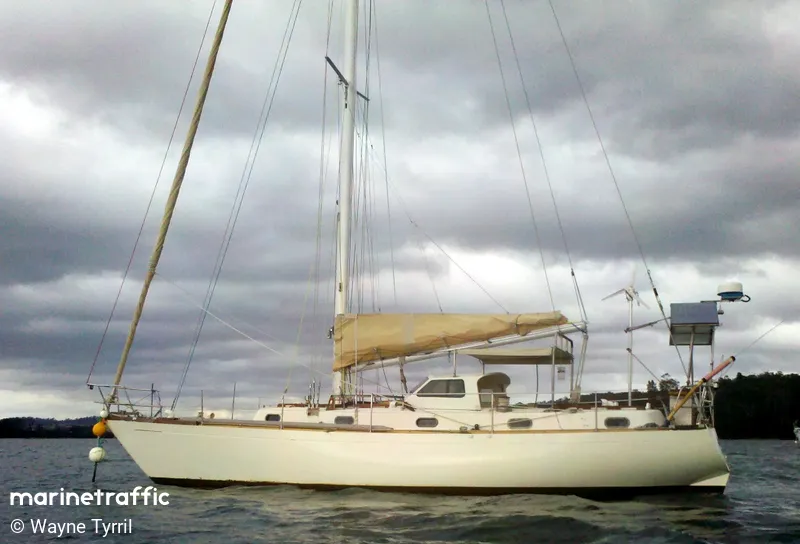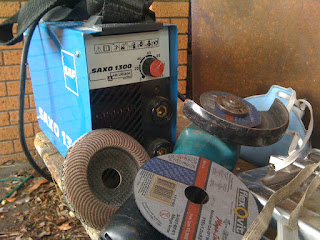 |
| The dome needs abit of "De-icing" |
I was Lucky when I bought Reiger, Jim Dilly had already put a canvas spray dodger on her. If he hadn't it probably would have taken me a few years to work out how great they are. I am sure I would have maintained that I liked the taste of salt water and by not having a spray dodger it improved my "feel" for the boat or some other utter rubbish along those lines, so Jim did me a big favor...
Reigers dodger had a fantastic canvas flap that zipped onto the back of the dodger and bungeed down to the cockpit completely enclosing the whole area under the dodger. With this fitted I could actually cook standing up in the companionway, inside my little canvas tent, warm and dry, even with driving rain from astern. The steam from cooking would rise and condense inside the dodger and not the cabin. Wet weather gear could be stashed either side of the hatch, out of the cabin, and in cold weather it kept alot of the heat in the boat, like an airlock, but still provided ventilation. I could even sail with the flap on. and of course the dodger kept me warm and dry at sea, all up it was brilliant...
My only complaints were that I couldn't work out how to fit a perspex dome to the hatch, and when I was sailing across the Tasman on my own I needed to climb right out into the cockpit to have a good lookaround, This required wet weather gear and a harness, and waking up properly - and I usually got at least a face full of salt water..
When it came time to fit a proper dodger to Snow Petrel I thought long and hard whether to put a canvas dodger or a hard dodger on the boat. We had built a series of hard dodgers for a few boats up at Launceston. The designer/artist was my friend Greg, he has a great eye for a nice looking dodger and after 3 builds we had worked out a quick strong method of building a hard dodger, But I was worried about how one might survive a southern ocean breaker landing smack bang ontop of it, at least with a canvas dodger I could just straighten the frame and stitch it back together, If I had been stupid enough not to fold it down...
The answer to building a stronger dodger came when I sailed on
2041, one of Chay Blyth's challenge 67's. The dodger onboard 2041 was maybe abit "practical" looking but had very strong knees at the after end that also doubled as somewhere to lean against. After seeing this I decided to go with a hard dodger, and as a bonus I could just squeeze a dome under the dodger on the main hatch and another on top of the dodger, above the hatch, meaning I would be able to have a look around without leaving the security of the main hatch.
It looks like this.
1 - 18 inch 6mm perspex dome, absolutely amazing view, doesn't steam up and can be used from inside the hatch or inside the cockpit. It is high enough to have a good view forward. It is a feature that I wouldn't be without. For tropical sailing I might fit it onto a hatch so it can be removed.
 |
| Little green hatted man is warm, dry and very happy! |
2 - Hand rails set inboard to serve as longitudinal stringers, and gives a comfortable seat on the edge of the dodger roof. By setting them inboard the are easy to hold onto when on the lee deck.
3 - The dodger top is 2 layers of 6mm plywood laminated into a curve. It also has glass sheathing and non skid paint. This is more than strong enough to jump on. I intend to put a mainsheet traveller on top of it at some point...
4 - At the aft edge of the top and the sides is an external laminated beam. Inside this is an aluminium boltrope extrusion to take the canvas flap, to close in the dodger. This Beam stiffens and strengthens the top. It also stops water blowing back from the dodger top into the cockpit. And It forms a good handhold, hence burying the aluminium track inside the wood to stop my fingers getting cold.
5 - Big plywood and glass knees strengthen the aft end of the dodger, they also have handholds and make a nice backrest, or place to lean against. They also give the canvas flap something to overlap to stop rain driving in. They are tied with several heavy layers of unidirectional glass onto the top of the dodger, and bolted to stainless tangs on the coamings.
6 - Cabin top is used as a step to get onto the dodger, it also makes the dodger look better to set it slightly inside the cabin edge, and it is easier to build.
7 - Windows are 4 mm perspex, designed to break before the dodger does...
8 - Dodger sides are 9mm ply, doubled in high load areas, with heavy biaxial fibreglass tape in all the corners. They are bolted through welded stainless steel tabs on the cabin top. a Sikaflex fillet seals it to the deck.
 |
| From Astern, a bit of food on the wharf to store somewhere... |
I spent alot of time looking at the ergonomics, mocking stuff up and trying to balance looks with functionality. I am happy with the results. There is room to sit in the cockpit completely under the dodger totally out of rain, snow or spray, and I can steer from this position, peering out the dome for a good look around. I need to add a few small windows to the top of the dodger so I can see the jib luff from this position.
I shifted the main winches aft 6 inches or so so I had space to sit on the cockpit coaming alongside the dodger steering with the tiller extension. This is very comfortable and gives a great view.
The dodger got its test on the way down to Antarctica, It copped a big southern ocean breaker, landed right on top of it, knocked us down and got some water below. I was sure it must have broken a window in the dodger but they survived. At some point I can imagine a storm bad enough to destroy the dodger, but if I survive I will just build another one, If I built it strong enough to survive anything it would be far two heavy, instead it is designed so that it cannot damage the watertight integrity of the boat.
One big advantage of having a dodger is that you can dress lighter, meaning when deck work needs doing you don't overheat, sweat and then get very cold as can happen if you are dressed very warmly for a windy cockpit watch with no shelter.
I think the dome/dodger combination is a big safety factor in cold water, keeping crew dry and warm, but some experienced sailors like Rolf and Deborah off Northern light don't have one, using the dome on the main hatch and an effective windvane instead. And I must say that if I got a bigger boat I would probably have more of a pilothouse setup, but with a sheltered area off the back.
I have sailed on a few boats that have a dodger sheltering the crew at the front of the cockpit but not the helmsman at the back of the cockpit. In my opinion this is stupid, the helmsman should be able to get their body out of the worst of the wind and spray, and ideally duck and get their eyes away from a dollop of spray. I have had my eyes get so much salt water driven into them that I could hardly see, A sensible dodger would have solved that problem.
On
Blizzard we really wished we had at least a half dodger over the exposed wheel to keep at least our hands dry (or a good autopilot...), but instead we had numb fingers and could only manage half hour tricks in bad weather. Spirit of Sydney had a big lexan dodger, covering most of the cockpit and giving the wheel some shelter, this worked well, and I could hand steer for hours in the worst weather. A big safety plus.
 |
| Now thats a dodger! All Polycarbonate on alloy frames, it goes right back to the helm, ideally the helm needs raising slightly for better visibility, but you can stand to the side and steer with you foot for excellant vis. Note the clutter on deck... |
My father got home from the trip on snowpetrel and quickly fitted a spray dodger and roller furling to their 45 foot gaff ketch, after the 30 years that we had to put up with being wet and cold, so at least he was convinced of the benefits. But he couldn't quite bring himself to add a dome. Saying it just wouldn't look right...
 |
| The original dodger that spawned provided the pattern for mine, Looks much sleeker on a 38 footer, Nice work Wayne, Greg and Grant. |
 |
Gosh Dad a spray dodger sure would be nice.... Note the Reefed Staysail on a boom.
Note the slightly raked angle of the dodger, this helps remove the illusion of the dodger being droopy, very important as a level dodger top will often result in the side panels looking slightly droopy due to the camber and fact that the sides are narrower at the forward edge.
Here you can see the lip at the aft end and the radius of the top. The inboard handrails are very good, providing a comfortable seat on the dodger.
Under construction, note the annex track buried all around the aft edge.
Plenty of room under the dodger, just enough headroom, and your whole body is out of spray and rain.
The dome was fantastic, here I am still inside the hatch with the door closed, perfect 360 view and safely wedged in place.
The only shot with the canvas closure flap at over the back of the dodger, Two bungees held it down so it was easy to lift and get out.It really kept in the heat, and kept out snow ,rain and spray.
|












































